Computer-Aided Diagnoses for Sore Throat Based on Dynamic Uncertain Causality Graph
Abstract
1. Introduction
2. Materials and Methods
2.1. Causal Expression of DUCG
2.2. The Inference Process of the DUCG
2.3. Sore Throat DUCG Modeling
 ) stands for LPR. It has two states; state 0 indicates its negative state and state 1 indicates its positive state with a priori probability of 0.03 (Pr{B23,1} = 0.03). This probability can be obtained from statistical data of the disease or depending on the experience of the clinical specialists. A history of reflux esophagitis is one risk factor for LPR; people with a history of reflux esophagitis can increase the incidence of LPR 10 times more than people without a reflux esophagitis history. As shown in Figure 3, we use the X-type variable numbered X74 (
) stands for LPR. It has two states; state 0 indicates its negative state and state 1 indicates its positive state with a priori probability of 0.03 (Pr{B23,1} = 0.03). This probability can be obtained from statistical data of the disease or depending on the experience of the clinical specialists. A history of reflux esophagitis is one risk factor for LPR; people with a history of reflux esophagitis can increase the incidence of LPR 10 times more than people without a reflux esophagitis history. As shown in Figure 3, we use the X-type variable numbered X74 ( ) to stand for the history of reflux esophagitis. SG23 (
) to stand for the history of reflux esophagitis. SG23 ( ) is a special logic gate; its logic specification table records the risk factor combination of X74 shown in Equation (4) [29]. Equation (4) means that when X74,1 is true, state 1 of SG23 is true (SG23,1). Otherwise, the state 0 is true (SG23,0). The different states of SG23 act with different affections to the incidence of the LPR. The special functional event variable SA23;23 records the strength of the effect of risk factors on the disease shown in Equation (5).
) is a special logic gate; its logic specification table records the risk factor combination of X74 shown in Equation (4) [29]. Equation (4) means that when X74,1 is true, state 1 of SG23 is true (SG23,1). Otherwise, the state 0 is true (SG23,0). The different states of SG23 act with different affections to the incidence of the LPR. The special functional event variable SA23;23 records the strength of the effect of risk factors on the disease shown in Equation (5).
 ) stands for the incidence of the disease when X74,1 is true, Pr{BX23,1} = Pr{SA23,1;23,1B23,1} = 10 × 0.03 = 0.3. In this way, we express the effect of risk factors on disease incidence in DUCG. Manifestations caused by LPR are drowning as the children of the BX-type variable; most of them are represented by the X-type variable standing for the nonspecific clinical manifestations, except the manifestation “proton pump inhibitors are effective in the treatment of this disease”. The manifestation SX160 (
) stands for the incidence of the disease when X74,1 is true, Pr{BX23,1} = Pr{SA23,1;23,1B23,1} = 10 × 0.03 = 0.3. In this way, we express the effect of risk factors on disease incidence in DUCG. Manifestations caused by LPR are drowning as the children of the BX-type variable; most of them are represented by the X-type variable standing for the nonspecific clinical manifestations, except the manifestation “proton pump inhibitors are effective in the treatment of this disease”. The manifestation SX160 ( , proton pump inhibitors are effective in the treatment of this disease) is the clinical gold standard for LPR diagnosis; it is represented by the SX-type variable. When the manifestation appears, the disease can be directly diagnosed based on this evidence. Appendix B shows the parameters of causal strength between variables of the sub-DUCG of LPR shown in Figure 3. This sub-DUCG model describes the relationship between LPR and its clinical diagnostic information, including the involved symptoms, signs, laboratory tests, diagnostic gold standard, risk factors, and other information. This information is understandable to doctors.
, proton pump inhibitors are effective in the treatment of this disease) is the clinical gold standard for LPR diagnosis; it is represented by the SX-type variable. When the manifestation appears, the disease can be directly diagnosed based on this evidence. Appendix B shows the parameters of causal strength between variables of the sub-DUCG of LPR shown in Figure 3. This sub-DUCG model describes the relationship between LPR and its clinical diagnostic information, including the involved symptoms, signs, laboratory tests, diagnostic gold standard, risk factors, and other information. This information is understandable to doctors.3. Results
4. Conclusions
Author Contributions
Funding
Institutional Review Board Statement
Informed Consent Statement
Data Availability Statement
Acknowledgments
Conflicts of Interest
Appendix A
 ) is used to represent the root cause that causes other variables to occur.
) is used to represent the root cause that causes other variables to occur. ), which is used to represent the result caused by the root cause variable, can also be used as the cause of other variables.
), which is used to represent the result caused by the root cause variable, can also be used as the cause of other variables. ), only connects with one root cause variable. If it is true, then the corresponding root cause must be true.
), only connects with one root cause variable. If it is true, then the corresponding root cause must be true. ), when the cause of a variable’s occurrence is unknown, then a D-type variable is used to represent the root cause variable that causes it to occur.
), when the cause of a variable’s occurrence is unknown, then a D-type variable is used to represent the root cause variable that causes it to occur. ) is only used to express logical relationships between the B-type variable and X-type variables.
) is only used to express logical relationships between the B-type variable and X-type variables. ) integrates multiple root cause events as one cause event. It expresses the joint affection of multiple causes.
) integrates multiple root cause events as one cause event. It expresses the joint affection of multiple causes. ) can organize the variable by group, making the DUCG more readable and understandable.
) can organize the variable by group, making the DUCG more readable and understandable. ) is used to represent the logic combinations of its child variables.
) is used to represent the logic combinations of its child variables. ) is the special functional event variable. It is only used between the SG-type variable and BX-type variable, quantifying the joint affection of the variable combinations in the logical gate specification of the SG-type variable.
) is the special functional event variable. It is only used between the SG-type variable and BX-type variable, quantifying the joint affection of the variable combinations in the logical gate specification of the SG-type variable.Appendix B
References
- Currò, V.; Buonuomo, P.S.; De Rose, P.; Onesimo, R.; Vituzzi, A.; D’Atri, A. The evolution of web-based medical information on sore throat: A longitudinal study. J. Med. Internet Res. 2003, 5, e884. [Google Scholar] [CrossRef]
- Dalalah, D.; Magableh, S. remote fuzzy multicriteria diagnosis of sore throat. Telemed. E-Health 2008, 14, 656–665. [Google Scholar] [CrossRef] [PubMed]
- Wahab, D.; Bichard, J.; Shah, A.; Mann, B. Just a sore throat? Uncommon causes of significant respiratory disease. Case Rep. 2013, 2013, bcr2013008739. [Google Scholar] [CrossRef] [PubMed]
- Leaper, D.J.; Dombal, F.; Horrocks, J.C.; Staniland, J.R. Computer-Assisted Diagnosis of Abdominal Pain Using “Estimates” Provided by Clinicians. Br. J. Surg. 1972, 59, 897–898. [Google Scholar] [CrossRef]
- Anbar, M. Computer assisted clinical decisions: Present scope, limitations, and future. Int. J. Technol. Assess. Health Care 1986, 2, 168–176. [Google Scholar] [CrossRef]
- Innocent, P.R.; John, R.I. Computer aided fuzzy medical diagnosis. Inf. Sci. 2004, 162, 81–104. [Google Scholar] [CrossRef]
- Alkahlout, M.A.; Abujamie, T.N.; Abu-Naser, S.S. Throat Problems Expert System Using SL5. Int. J. Acad. Inf. Syst. Res. (IJAISR) 2021, 5, 68–78. [Google Scholar]
- Shortliffe, E.H. Computer-based medical consultations: MYCIN. J. Clin. Eng. 1976, 388. [Google Scholar] [CrossRef]
- Weiss, S.M.; Kulikowski, C.A.; Amarel, S.; Safir, A. A model-based method for computer-aided medical decision-making. Artif. Intell. 1978, 11, 145–172. [Google Scholar] [CrossRef]
- Myers, J.; Pople, H.; Miller, R.; Myers, J.; Pople, H.; Miller, R.; Myers, J.; Pople, H.; Miller, R.; Myers, J. INTERNIST-I, An Experimental Computer-Based Diagnostic Consultant for General Internal Medicine. In Computer-Assisted Medical Decision Making; Springer: New York, NY, USA, 1985. [Google Scholar]
- Tunmibi, S.; Adeniji, O.; Aregbesola, A.; Dasylva, A. A rule based expert system for diagnosis of fever. Int. J. Adv. Res. 2013, 1, 343–348. [Google Scholar]
- Kumar, K.A.; Singh, Y.; Sanyal, S. Hybrid approach using case-based reasoning and rule-based reasoning for domain independent clinical decision support in ICU. Expert Syst. Appl. 2009, 36, 65–71. [Google Scholar] [CrossRef]
- Joloudari, J.H.; Saadatfar, H.; Dehzangi, A.; Shamshirband, S. Computer-aided decision-making for predicting liver disease using PSO-based optimized SVM with feature selection. Inform. Med. Unlocked 2019, 17, 100255. [Google Scholar] [CrossRef]
- Mazurowski, M.A.; Habas, P.A.; Zurada, J.M.; Lo, J.Y.; Baker, J.A.; Tourassi, G.D. Training neural network classifiers for medical decision making: The effects of imbalanced datasets on classification performance. Neural Netw. 2008, 21, 427–436. [Google Scholar] [CrossRef]
- Ince, T.; Kiranyaz, S.; Pulkkinen, J.; Gabbouj, M. Evaluation of global and local training techniques over feed-forward neural network architecture spaces for computer-aided medical diagnosis. Expert Syst. Appl. 2010, 37, 8450–8461. [Google Scholar] [CrossRef]
- Vasilakos, A.V.; Tang, Y.; Yao, Y. Neural networks for computer-aided diagnosis in medicine: A review. Neurocomputing 2016, 216, 700–708. [Google Scholar]
- Zribi, M.; Boujelbene, Y. Neural networks in the medical decision making. Int. J. Comput. Sci. Inf. Secur. 2016, 14, 70. [Google Scholar]
- Arabasadi, Z.; Alizadehsani, R.; Roshanzamir, M.; Moosaei, H.; Yarifard, A.A. Computer aided decision making for heart disease detection using hybrid neural network-Genetic algorithm. Comput. Methods Programs Biomed. 2017, 141, 19–26. [Google Scholar] [CrossRef] [PubMed]
- Srivastava, A.K.; Kumar, Y.; Singh, P.K. Computer aided diagnostic system based on SVM and K harmonic mean based attribute weighting method. Obes. Med. 2020, 19, 100270. [Google Scholar] [CrossRef]
- D’Ambrosi, R.; Biancardi, E.; Massari, G.; Ragone, V.; Facchini, R.M. Computer-assisted Bayesian diagnosis of connective tissue diseases. Methods Inf. Med. 1981, 20, 19–23. [Google Scholar]
- Xiang, Y.; Pant, B.; Eisen, A.; Beddoes, M.P.; Poole, D. Multiply sectioned Bayesian networks for neuromuscular diagnosis. Artif. Intell. Med. 1993, 5, 293–314. [Google Scholar] [CrossRef]
- Tosetto, A.; Castaman, G.; Rodeghiero, F. Evidence-based diagnosis of type 1 von Willebrand disease: A Bayes theorem approach. Blood 2008, 111, 3998–4003. [Google Scholar] [CrossRef] [PubMed]
- Jackins, V.; Vimal, S.; Kaliappan, M.; Mi, Y.L. AI-based smart prediction of clinical disease using random forest classifier and Naive Bayes. J. Supercomput. 2020, 77, 5198–5219. [Google Scholar] [CrossRef]
- Zhang, Q. Dynamic Uncertain Causality Graph for Knowledge Representation and Reasoning: Discrete DAG Cases. J. Comput. Sci. Technol. 2012, 27, 1–23. [Google Scholar] [CrossRef]
- Zhang, Q.; Dong, C.; Cui, Y.; Yang, Z. Dynamic Uncertain Causality Graph for Knowledge Representation and Probabilistic Reasoning: Statistics Base, Matrix, and Application. IEEE Trans. Neural Netw. Learn. Syst. 2014, 25, 645. [Google Scholar] [CrossRef] [PubMed]
- Zhang, Q. Dynamic Uncertain Causality Graph for Knowledge Representation and Probabilistic Reasoning: Directed Cyclic Graph and Joint Probability Distribution. IEEE Trans. Neural Netw. Learn. Syst. 2015, 26, 1503–1517. [Google Scholar] [CrossRef] [PubMed]
- Zhang, Q. Dynamic Uncertain Causality Graph for Knowledge Representation and Reasoning: Continuous Variable, Uncertain Evidence, and Failure Forecast. IEEE Trans. Syst. Man Cybern. Syst. 2017, 45, 990–1003. [Google Scholar] [CrossRef]
- Zhang, Q.; Yao, Q. Dynamic Uncertain Causality Graph for Knowledge Representation and Reasoning: Utilization of Statistical Data and Domain Knowledge in Complex Cases. IEEE Trans. Neural Netw. Learn. Syst. 2018, 29, 1637–1651. [Google Scholar] [CrossRef]
- Zhang, Q.; Bu, X.; Zhang, M.; Zhang, Z.; Hu, J. Dynamic uncertain causality graph for computer-aided general clinical diagnoses with nasal obstruction as an illustration. Artif. Intell. Rev. 2021, 54, 27–61. [Google Scholar] [CrossRef]

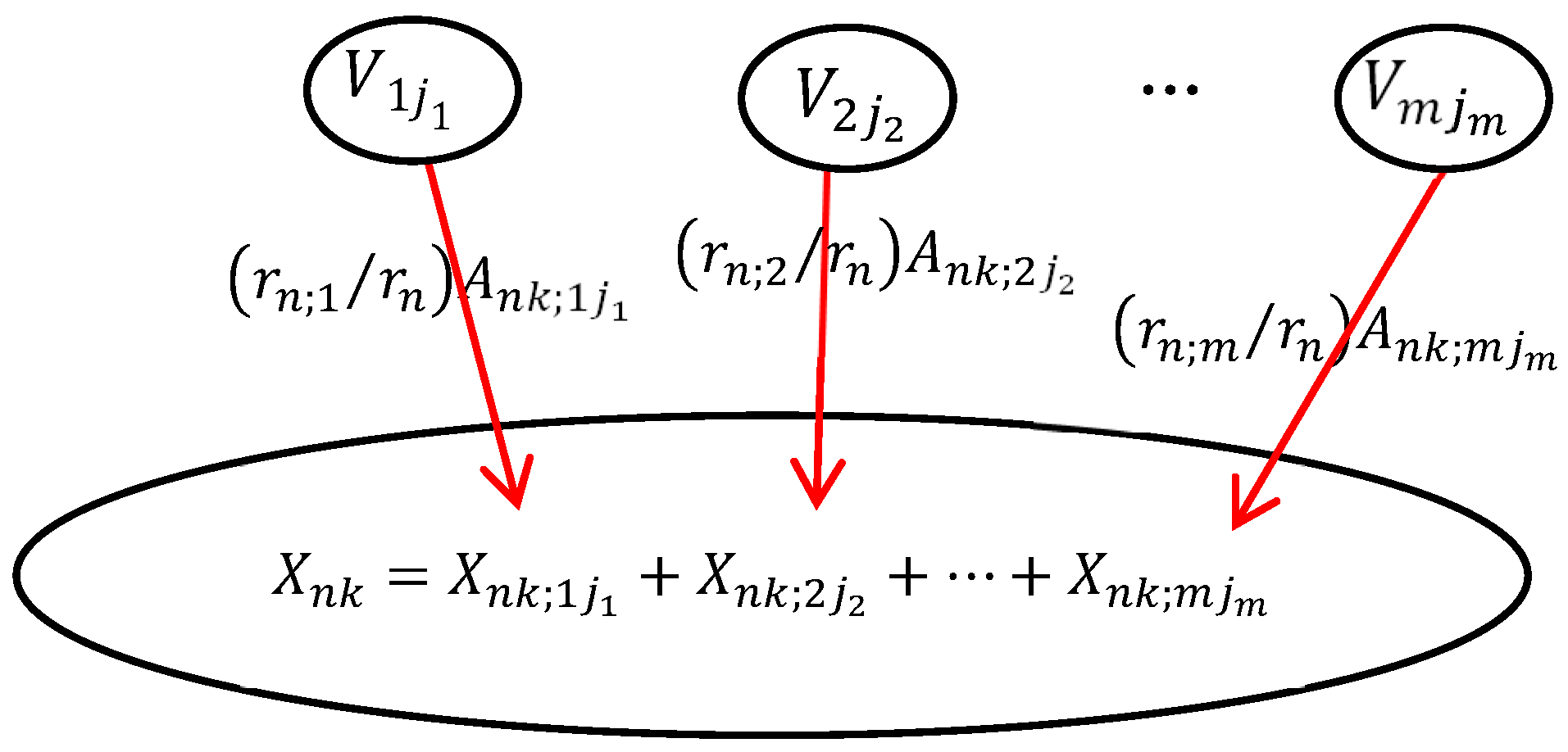
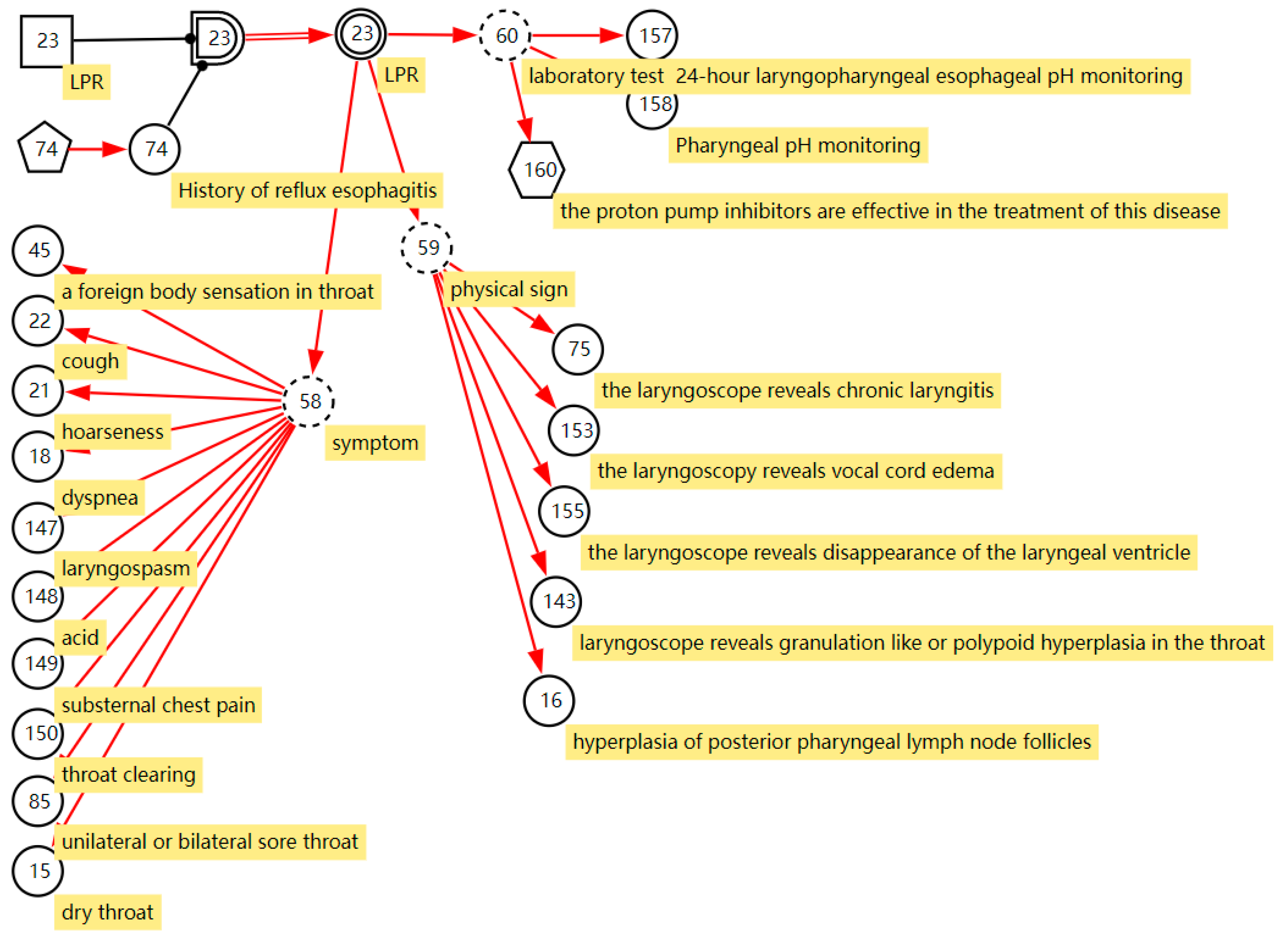
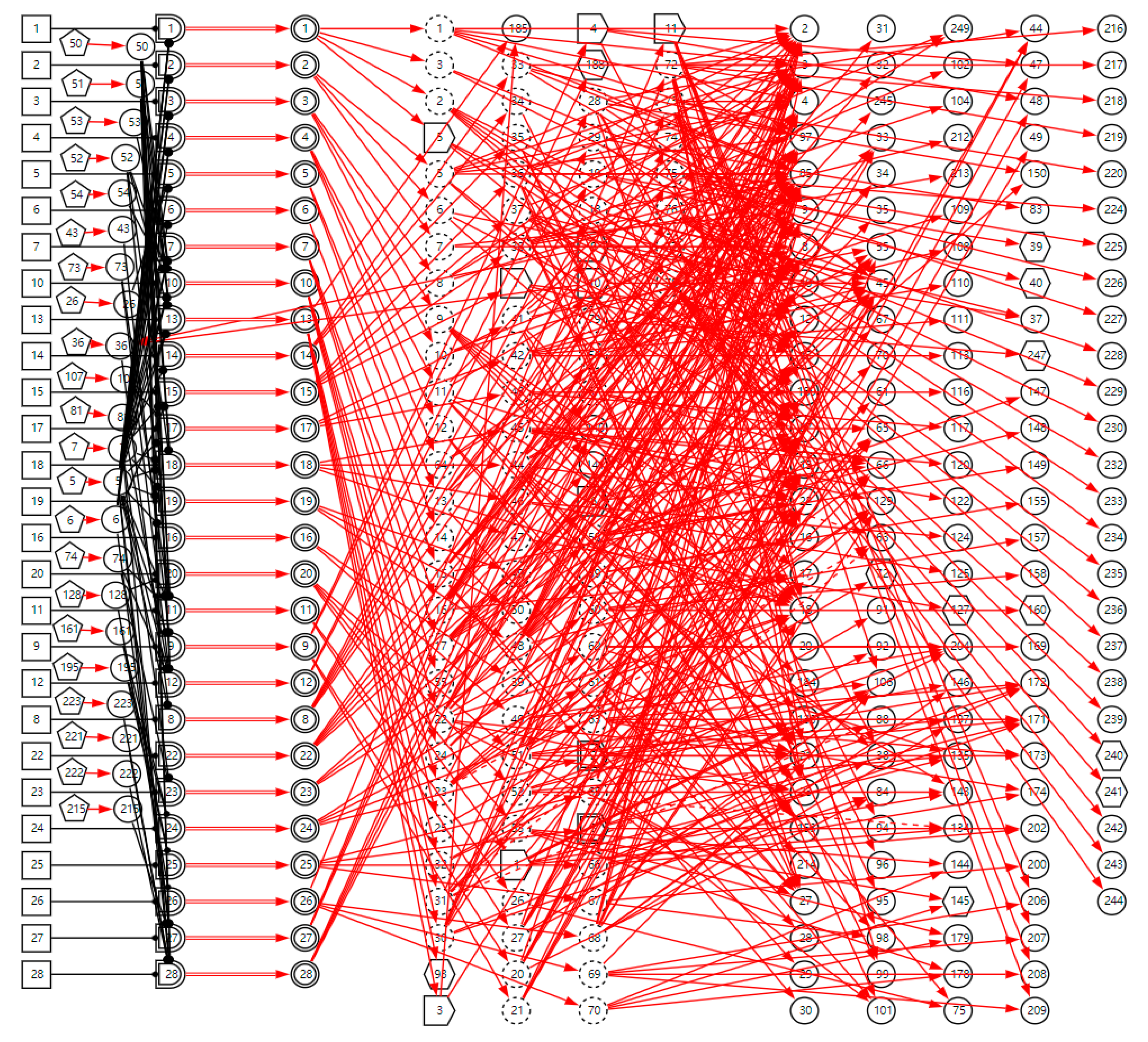
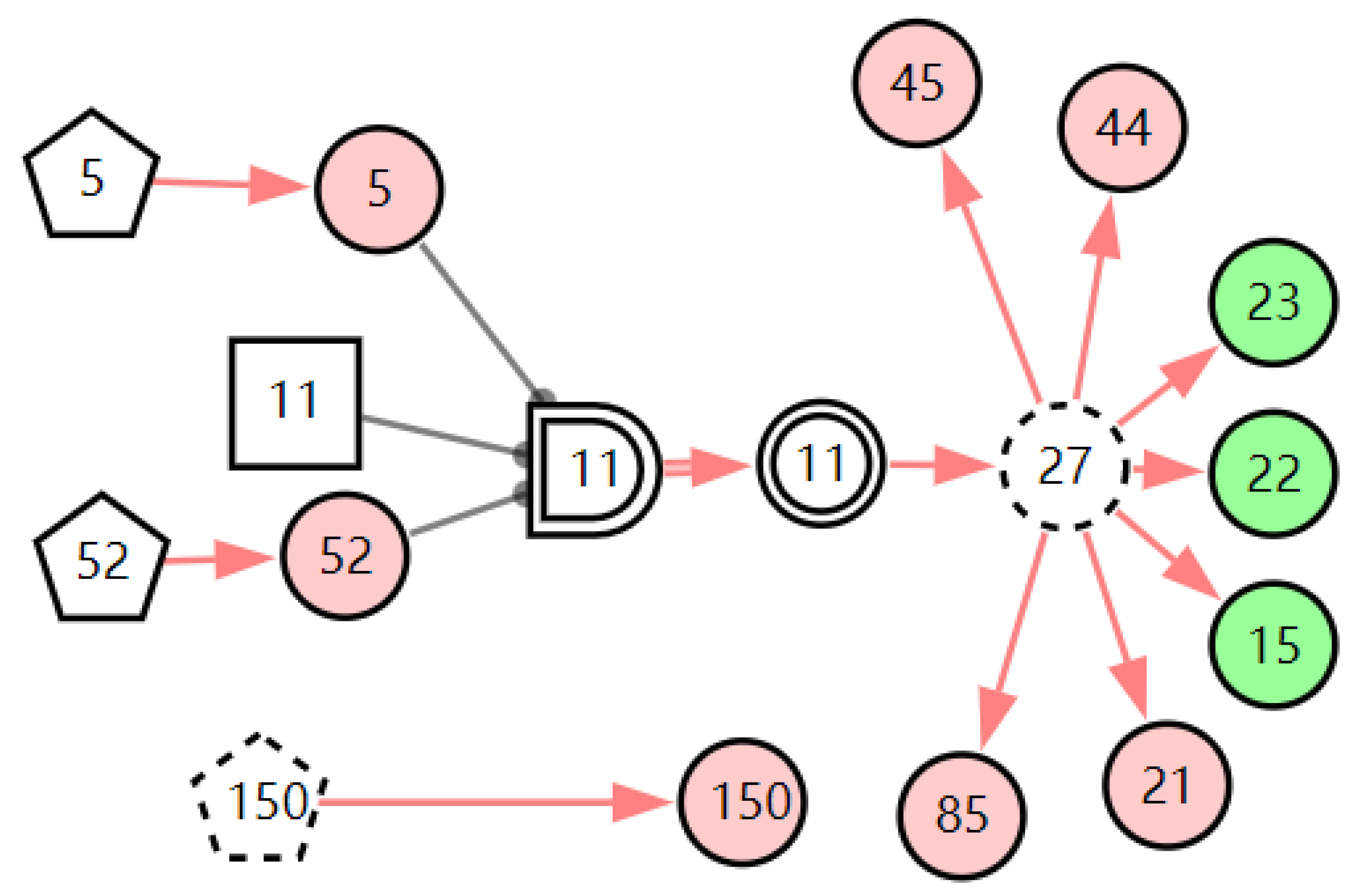
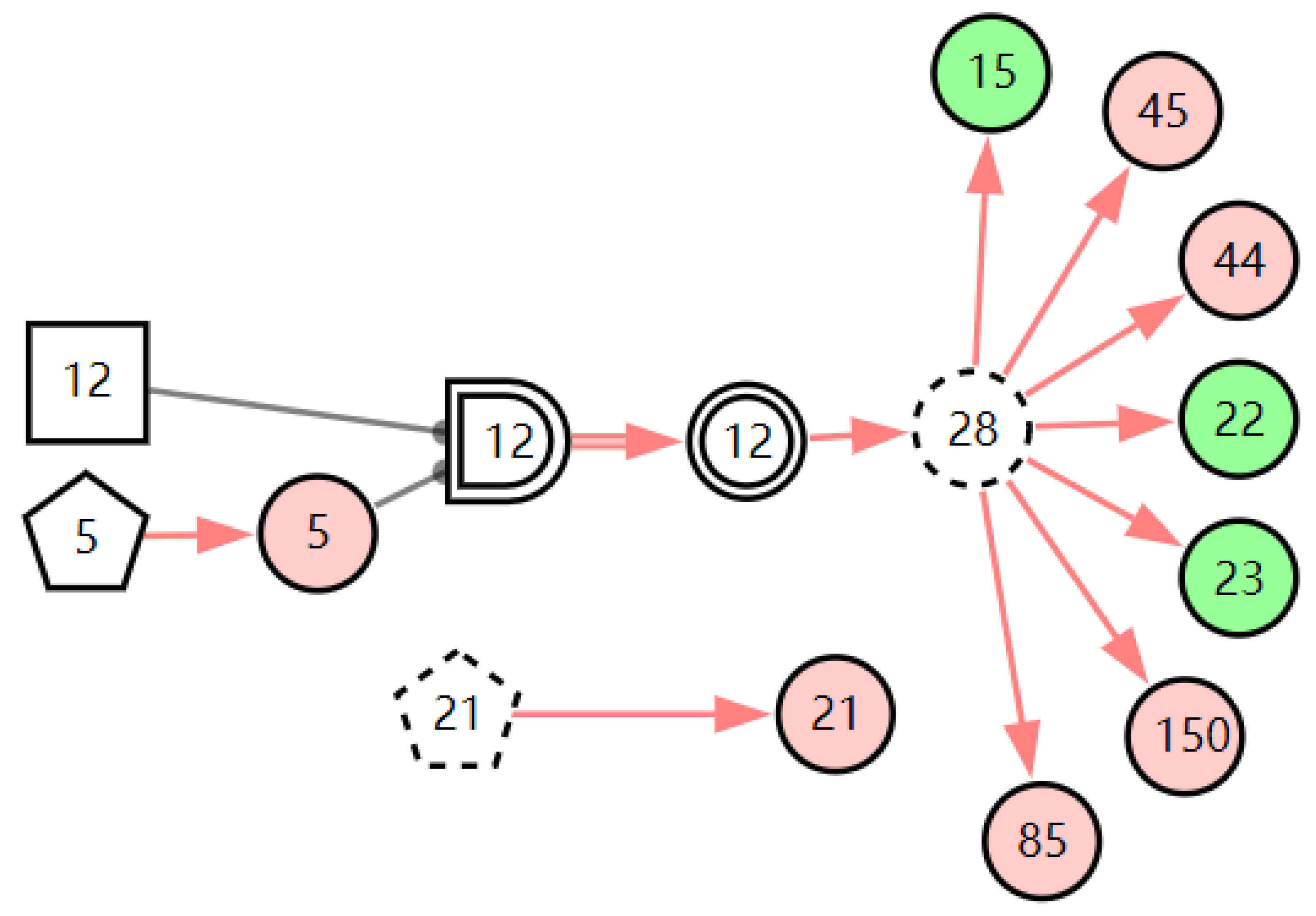

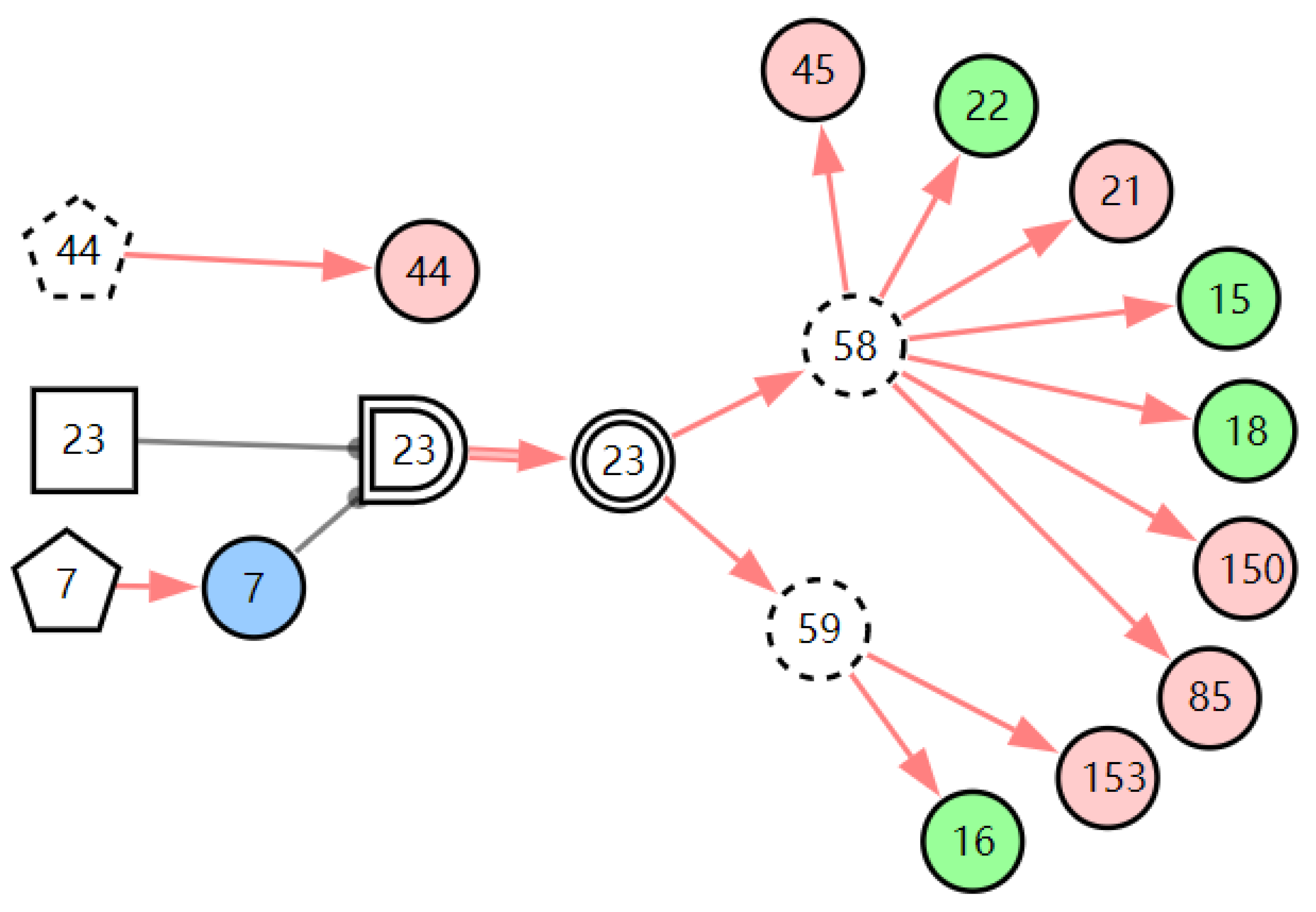

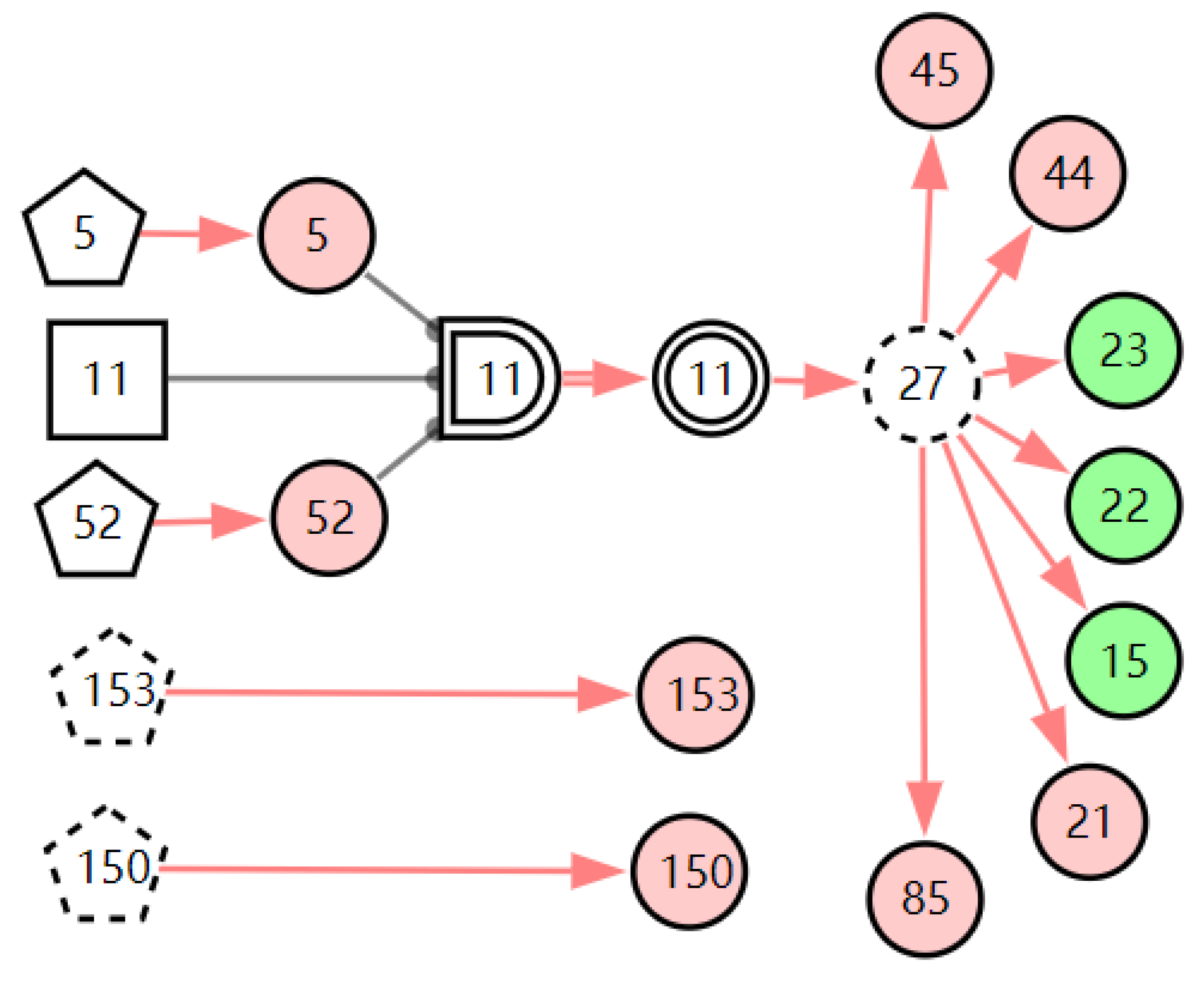

| Classification | Disease | ID |
|---|---|---|
| Inflammation | Acute tonsillitis | B1 |
| Acute pharyngitis | B2 | |
| Acute epiglottitis | B3 | |
| Acute laryngitis | B4 | |
| Chronic laryngitis | B11 | |
| Chronic pharyngitis | B12 | |
| Chronic tonsillitis | B9 | |
| Peritonsillitis | B19 | |
| Peritonsillar abscess | B7 | |
| Trauma | Pharyngeal burn | B5 |
| Closed laryngeal trauma | B17 | |
| Foreign body | Pharyngeal foreign body | B8 |
| Tumor | Cancer of the larynx | B10 |
| Tonsil carcinoma | B13 | |
| Carcinoma of hypopharynx | B18 | |
| Tonsil lymphoma | B22 | |
| Tuberculosis | Laryngeal tuberculosis | B20 |
| Pharyngeal tuberculosis | B26 | |
| Syphilis | Laryngeal syphilis | B24 |
| Pharyngeal syphilis | B25 | |
| Uncommon disease | Glossopharyngeal neuralgia | B6 |
| Styloid process syndrome | B14 | |
| Infectious mononucleosis | B15 | |
| Cardiovascular disease | Coronary heart disease | B28 |
| Reflux disease | Laryngopharyngeal reflux | B23 |
| Bacterial or viral infection | Upper respiratory tract infection | B27 |
| Throat ulcers | B16 |
| Disease | ID | Probability |
|---|---|---|
| Chronic laryngitis | B11,1 | 39.52% |
| Chronic pharyngitis | B12,1 | 26.56% |
| Laryngopharyngeal reflux | B23,1 | 25.50% |
| Chronic tonsillitis | B9,1 | 5.89% |
| Acute laryngitis | B4,1 | 1.92% |
| Disease | ID | Probability |
|---|---|---|
| Laryngopharyngeal reflux | B23,1 | 82.74% |
| Acute laryngitis | B4,1 | 11.11% |
| Chronic laryngitis | B11,1 | 6.11% |
| Chronic pharyngitis | B12,1 | 0.017% |
| Acute epiglottitis | B3,1 | 0.0039% |
| Disease Name | Total Cases | Test cases | True Cases | Accuracy |
|---|---|---|---|---|
| Acute tonsillitis | 388 | 10 | 10 | 100% |
| Acute pharyngitis | 129 | 10 | 10 | 100% |
| Acute epiglottitis | 233 | 10 | 10 | 100% |
| Acute laryngitis | 204 | 10 | 10 | 100% |
| Pharyngeal burn | 0 | 0 | 0 | 0% |
| Glossopharyngeal neuralgia | 6 | 4 | 4 | 100% |
| Peritonsillar abscess | 26 | 10 | 10 | 100% |
| Pharyngeal foreign body | 11 | 10 | 10 | 100% |
| Chronic tonsillitis | 831 | 10 | 10 | 100% |
| Cancer of the larynx | 55 | 10 | 10 | 100% |
| Chronic laryngitis | 14 | 9 | 9 | 100% |
| Chronic pharyngitis | 255 | 10 | 10 | 100% |
| Throat ulcers | 45 | 9 | 9 | 100% |
| Tonsil carcinoma | 4 | 4 | 4 | 100% |
| Styloid process syndrome | 2 | 2 | 2 | 100% |
| Infectious mononucleosis | 53 | 10 | 9 | 90% |
| Closed laryngeal trauma | 8 | 8 | 8 | 100% |
| Carcinoma of hypopharynx | 15 | 10 | 10 | 100% |
| Peritonsillitis | 120 | 10 | 9 | 90% |
| Laryngeal tuberculosis | 14 | 10 | 10 | 100% |
| Tonsil lymphoma | 1 | 1 | 1 | 100% |
| Laryngopharyngeal reflux | 6 | 5 | 5 | 100% |
| Laryngeal syphilis | 0 | 0 | 0 | 0% |
| Pharyngeal syphilis | 0 | 0 | 0 | 0% |
| Pharyngeal tuberculosis | 2 | 2 | 2 | 100% |
| Upper respiratory tract infection | 157 | 10 | 10 | 100% |
| Coronary heart disease | 13 | 9 | 9 | 100% |
| Total | 2592 | 196 | 194 | 98.96% |
| Disease | Diagnosed Cases | Agreed Diagnoses |
|---|---|---|
| Pharyngeal foreign body | 48 | 48 |
| Throat ulcers | 55 | 55 |
| Carcinoma of hypopharynx | 3 | 3 |
| Glossopharyngeal neuralgia | 18 | 18 |
| Upper respiratory tract infection | 2625 | 2625 |
| Chronic pharyngitis | 564 | 564 |
| Chronic laryngitis | 152 | 152 |
| Chronic tonsillitis | 65 | 65 |
| Acute pharyngitis | 1188 | 1188 |
| Acute epiglottitis | 809 | 809 |
| Chronic laryngitis | 907 | 906 |
| Acute tonsillitis | 425 | 425 |
| Coronary heart disease | 325 | 325 |
| Laryngopharyngeal reflux | 29 | 29 |
| Peritonsillitis | 17 | 17 |
| Peritonsillar abscess | 6 | 6 |
| Total | 7236 | 7235 |
Disclaimer/Publisher’s Note: The statements, opinions and data contained in all publications are solely those of the individual author(s) and contributor(s) and not of MDPI and/or the editor(s). MDPI and/or the editor(s) disclaim responsibility for any injury to people or property resulting from any ideas, methods, instructions or products referred to in the content. |
© 2023 by the authors. Licensee MDPI, Basel, Switzerland. This article is an open access article distributed under the terms and conditions of the Creative Commons Attribution (CC BY) license (https://creativecommons.org/licenses/by/4.0/).
Share and Cite
Bu, X.; Zhang, M.; Zhang, Z.; Zhang, Q. Computer-Aided Diagnoses for Sore Throat Based on Dynamic Uncertain Causality Graph. Diagnostics 2023, 13, 1219. https://doi.org/10.3390/diagnostics13071219
Bu X, Zhang M, Zhang Z, Zhang Q. Computer-Aided Diagnoses for Sore Throat Based on Dynamic Uncertain Causality Graph. Diagnostics. 2023; 13(7):1219. https://doi.org/10.3390/diagnostics13071219
Chicago/Turabian StyleBu, Xusong, Mingxia Zhang, Zhan Zhang, and Qin Zhang. 2023. "Computer-Aided Diagnoses for Sore Throat Based on Dynamic Uncertain Causality Graph" Diagnostics 13, no. 7: 1219. https://doi.org/10.3390/diagnostics13071219
APA StyleBu, X., Zhang, M., Zhang, Z., & Zhang, Q. (2023). Computer-Aided Diagnoses for Sore Throat Based on Dynamic Uncertain Causality Graph. Diagnostics, 13(7), 1219. https://doi.org/10.3390/diagnostics13071219





